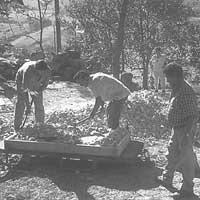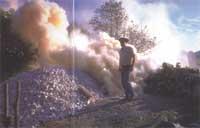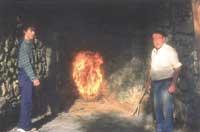CALERAS, Lime kilns
The use of live lime that improved the quality of farmland was widespread in our territory until the middle of this century. The caleras were special ovens used for the manufacture of live lime by calcining the lime.

Powers of quicklime for the treatment and correction of agricultural land XVIII. They were known in the early 20th century. In the book Historical Ethnography of Navarre, Julio Caro Baroja collected the testimony of the parish priest of Juan de Armasa Beintza-Labaien, according to which the discovery of lime was given in Lekunberri. Thus, in 1705-1709, in the famine of the Navarre mountain, the burnt and pulverized lime warmed the land that was actually cold.
From those years and largely with the spread of corn, the caleros or swans spread throughout the Basque Country. They were used for two and a half centuries, until throughout this century they were diminishing and disappeared completely around 1950.
Unfortunately, today most of the caleras are deteriorated and few people can give precise explanations about their functioning.
Caleras of various types

As explained by the Leitza calero, José Sagastibeltza, who has lit three caleras in recent years, among us there were two types of caleras. Known as garbage ovens were the oldest stone ovens supporting the fire. In them the limestone was accumulated in a limestone vault and under it the oak wood and beech is burned during the nights and days. At the bottom of the oven was the ignition mouth and a second hole regulated the air inlet. When the cooking ended in about six days, the fire was extinguished and after letting cool a couple of days came out quicklime.

The other carobimot called Arragoa had a continuous process. The stone and fuel were layered and the lime was extracted underneath by a metal mesh.
Crucible process
The inner cylinder of the crucible had an approximate height of 5 meters and a diameter of 1.2 meters. To facilitate the work they were built on slopes that facilitated access to the upper and lower mouths.
The oven went on and began to heat with completely dried brooms for three hours. Then the oak chips were added for another 2-3 hours and then you could start using thicker woods.

The calcer, observing the smoke, could know in what steps was cooking. The white color of the smoke indicated that the temperature was lower than enough and that the blues were warming well. The holes on the bottom wall of the furnace regulated the air inlet.
Once the oven was well heated, a calcareous layer of apple size was added and added alternating layers of wood and limestone.
At 10 hours of light, the first pieces of lime fell from the net, but when it was irregularly burned it was put back in the oven. Every two hours the oven was filled with a layer of alternating wood of stone and oak, beech and chestnut.

The amount of rock to be used depended on the amount of lime to be obtained, since the process was continuous, since as the lime was extracted the oven was filled with fuel. At 24-50 hours after the ignition, the oven temperature stabilized around 1000 C and the process was then carried out. The well cooked lime quickly cools and was stored in a shed until it was expanded in the fields. One part was reserved for the manufacture of dairy and was mainly used to whiten the walls of the hamlets.
The calera remained lit between 7 and 15 days, depending on the hamlets it was going to supply. During those days the head of the Calera and his companions carried out with enthusiasm Ian and, once the work was finished, after a series of hardships and sweats, a good dinner ended with this jewel.





